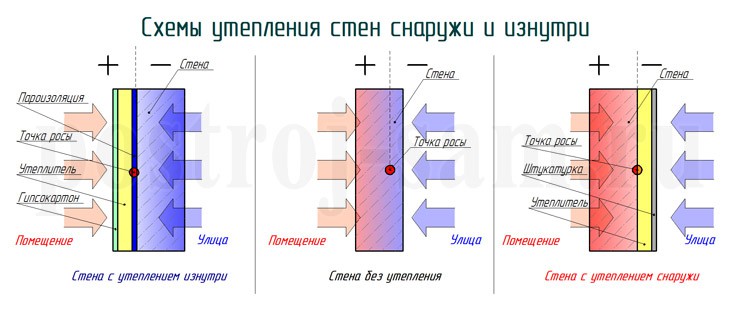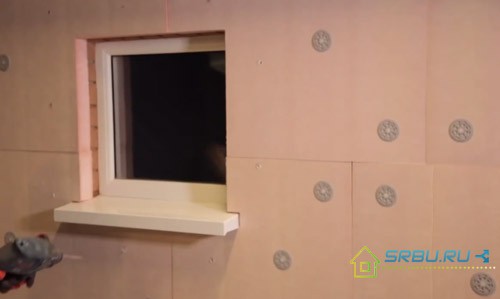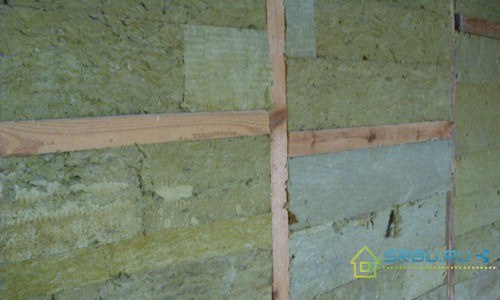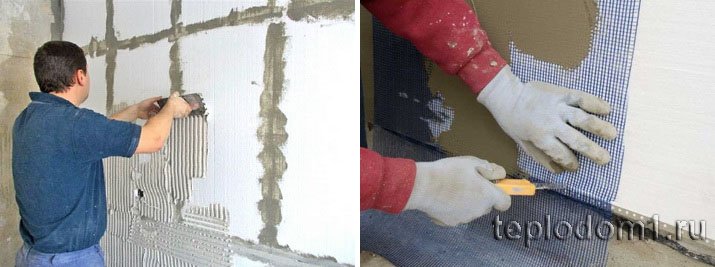How to insulate walls from the outside of the house and from the inside? This question is often of interest to the owners of their homes. At the same time, you should not be a qualified builder to do everything yourself. The main thing is that you need a great desire, a little money to purchase material for insulation, and the article will tell you how to do it correctly.
Before you properly insulate the walls of an apartment, you need to get acquainted with the characteristics of insulation materials (see), and choose exactly the one you need for a particular room. The main property of a heat insulator is its thermal conductivity, which shows how much heat can go through this material.
There are two types of thermal insulation:
- Reflective type designed to reduce heat consumption by reducing infrared radiation. Ideal for warming saunas and baths.
- Preventive type thermal insulation, it is used most often, while heaters with a low value of thermal conductivity are used. Such materials can be: inorganic, organic, mixed.
Inorganic heat insulators include:
- Mineral wool. It can be slag and stone (see).
- Glass wool.
- Ceramic wool.
Thermal insulators on an organic basis include such heaters as:
- Arbolite.
- Polyvinyl chloride foam.
- Made of chipboard (chipboard).
- From DVIP (fiberboard).
- Polyurethane foam.
- Mipora or penoizol.
- Expanded polystyrene.
- Made of foamed polyethylene.
- Fibrolite.
- Sotoplastic.
- Ecowool.
For the manufacture of mixed-type heat insulators, asbestos mixtures are used with the addition of:
- Micas.
- Dolomite.
- Perlite.
- Diatomite.
To bind the base, mineral components are introduced.
Features of house insulation outside and inside
Advice: It is necessary to insulate the walls of the building from the outside, and use the thermal insulation of the walls from the inside only in extreme cases.
The diagram shows three states of the wall of a building that has insulation: outside, inside and without insulation:

The dew point is the place where water vapor turns into water, while creating condensation.
The diagram shows:
- To the left of the dew point, the positive temperature is located.
- To the right is the minus one.
The features of wall insulation from the inside are:
- The wall is left unprotected from home heat. In this case, the heat barrier from the insulation does not let it into the wall, which will lead in winter to a significant effect of frost on it, constant moisture (see), which will not have time to dry out.
- At the dew point, condensation will collect. This point is as close as possible to the room, which will lead to the maximum formation of moisture in this place.
- Permanent condensation, without natural drying, will cause fungi and mold to appear on the wall.
- The diagram shows that without insulation, there will be less moisture on the inside on the wall than after insulation from the inside.
Features of wall insulation outside:
- From the street from the cold, the wall is protected by insulation, and taking into account the technology of insulation, the wall is warmed up from the inside by home heat, and even if condensation appears and moisture is absorbed, the wall will soon begin to dry out.
- The dew point is removed from the room closer to the street, which means that the condensation will be farther from the room.
- External insulation will significantly preserve heat in the house.
If the need arises: it is necessary to insulate the walls from wood concrete, first of all, it is necessary to bear in mind that this should be done outside the house.
To insulate it, the following are used:
- Mineral wool.
- Expanded polystyrene.
- Polyurethane foam.
How to properly use expanded polystyrene for external insulation of the house
To determine whether it is possible to insulate walls with expanded polystyrene, it is necessary to find out its properties.
These include:
- Poor heat conductivity.
- Very low vapor permeability and moisture absorption.
- Easily resists heavy loads.
- Does not react to strong compression and large tensile loads.
- It is lightweight.
- It is simply processed and mounted, it is easy to cut with a knife with your own hands.
Tip: When using expanded or extruded polystyrene foam, you can reliably insulate the entire structure. In this case, it is enough to take a material of small thickness, without laying a vapor barrier layer.
- Isolate "cold bridges" or joints between the plates and their abutment to the walls. For this, polyurethane foam is applied, applied to the entire plane of the sheet.
- To obtain even and sealed butt joints, it is better to purchase foam plates, which have a special edge with stepped edges.
- When using the material indoors, disc-type dowels are used or the plates are simply glued, as seen in the photo.
Each owner of his home chooses which side to insulate the walls, the main thing is to achieve the desired result.

The disadvantages of the material include:
- Poor noise protection.
- It can collapse at temperatures exceeding (+ 80 ° C), but this is not very relevant, as well as the fact that EPS boards dissolve in organic solvents.
How to insulate walls step by step with expanded polystyrene:
- The wall is cleared of dirt and leveled.
- When using glue, it is primed.
Tip: Do not allow significant pits on the wall that are not leveled with glue, if they are present after the installation of the insulation, voids remain between the wall and the expanded polystyrene plates: even from a slight blow or push, the pit can cause deformation of the material and even its breaking. The slab will not fit tightly on the wall to the bump.
- Expanded polystyrene is glued to the wall with a special glue for expanded polystyrene plates, or fixed with special "fungi".
- When using extruded polystyrene foam, the surface for applying the glue is roughened.
- To strengthen the structure, polystyrene foam is fixed at the same time with "fungi" and glue. This is a more reliable and correct solution.
- After installing the insulation, the outer walls are plastered (see), they can be overlaid with facing bricks.

Expanded polystyrene boards can be attached to a frame made of strips or other materials. Wherein:
- Slats are attached to the wall with a thickness not less than the thickness of the insulation, and better - more. This will create a ventilated space between the expanded polystyrene and the cladding material.
- The step between the slats should be such that the plates between them are inserted tightly enough and do not fall out.
- This type of installation is selected when. The slats, in this case, will be the basis for fixing the facing materials.
How walls are insulated with mineral wool
An equally popular way to insulate the walls of a house is to use mineral wool.

Unlike expanded polystyrene, mineral wool is not a very hard material, therefore it is better to install it using the frame method, but if you use a cotton wool insulation of sufficient density, you can glue the plates.
With the frame method:
- Slats or small bars are purchased.
- A frame structure is being erected on the wall.
- Insulation is laid or rolled out between the elements.
- On a concrete or brick wall, the bars are attached with dowel-nails, and on a wooden wall - with self-tapping screws.
- Mineral wool can be additionally fixed with "fungi", which will prevent it from rolling down.
- Such materials absorb moisture too much, this requires waterproofing on top of the insulation.
- It is advisable to build reliable protection from various rodents. For this, metal strips are installed along the edges of the wall.
Tip: When facing external walls with bricks, the insulation should be laid between the main and facing walls, and these two structures should be tied with special ties that pierce the mineral wool and hold it inside the wall, preventing it from rolling down.
How walls are insulated with polyurethane foam

This is the most modern type of insulation, but its price is the highest.
The advantages of the material include:
- After application, the polyurethane foam expands, which allows it to fill all cracks and cavities.
- Low vapor permeability, which does not require additional vapor barrier.
- Good adhesion or adhesion to the wall.
- High mechanical strength after hardening.
- Increased properties of heat and sound insulation.
The disadvantages of the material are:
- With a low density, polyurethane foam passes steam well, which must be taken into account when insulating a house.
- Low fire resistance.
- High price.
- Spraying is recommended by professionals, which increases the cost of insulation.
- With aging polyurethane foam, its thermal insulation properties deteriorate.
- Spraying is accompanied by the release of hazardous toxic substances, which requires the use of protective clothing.
Features of wall insulation from the inside
Why do many experts argue that it is impossible to insulate the walls from the inside of the room? In their opinion, this can lead to some unpleasant consequences.
These include:
- A significant reduction in the usable area of the room - from 0.5 m² to 2 m².
- Thermal insulation is possible only in a room from which all things are taken out, in extreme cases, moved away from the walls, which is not always convenient.
- When laying the insulation, it is necessary to provide for additional ventilation, to protect the heat insulator from condensation on it, which leads to the formation of mold and mildew on the walls.
- The cost of such work, in compliance with all the rules, will be quite high.
To avoid such unpleasant consequences with internal insulation, it is necessary:
- Choose the highest quality vapor barrier film. Butt seams on it must be carefully sealed.
- The heat-insulating material should not have high vapor permeability. The ideal option is that the vapor permeability indicator of the load-bearing wall is higher than that of the heat insulator. Then the steam will go out into the street.
- The insulation from the wall should lag behind at a minimum distance. It is not necessary to use the "beacons" method when gluing it, but to apply glue with a comb, which will avoid gaps between the wall and the insulation.

- To reduce humidity in the room, forced mechanical ventilation should be used, and valves should be installed on the windows.
- The thickness of the insulating layer must be carefully calculated taking into account the characteristics of the climatic zone.
- Before insulating walls, their surfaces must be treated with a special compound to prevent the formation of mold and mildew. Warming is carried out after the walls have dried.
Advice: First of all, it is necessary to eliminate the "cold bridges". To do this, a heat insulator is applied to problem areas using a vapor barrier. After that, the areas are masked with false columns or boxes.
If the house has monolithic walls, how to insulate them, how to properly insulate the walls with ursoy and many other issues are covered by the video in this article. Correctly insulating your home means saving money on heating it and maintaining a good microclimate in the house.



